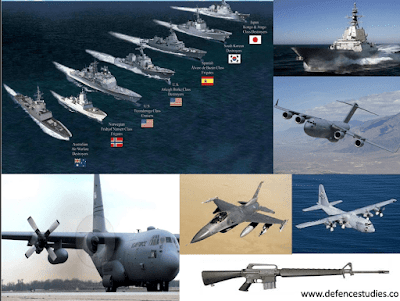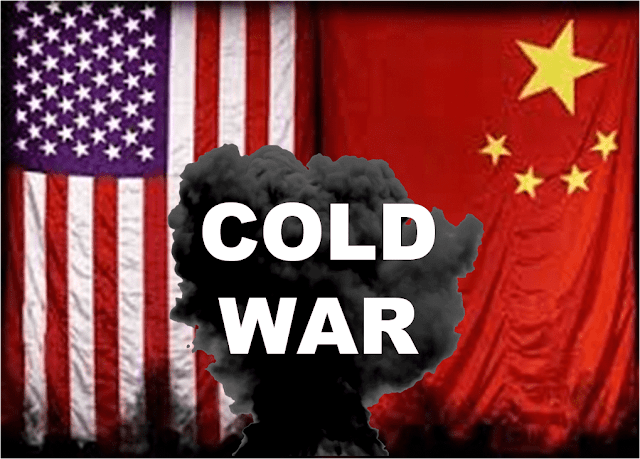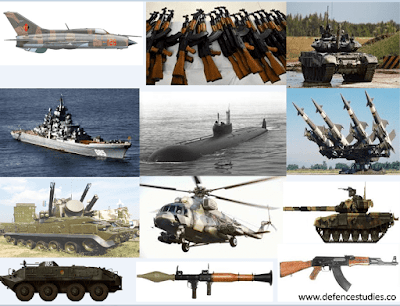Arms Aid is one of the most common and most prevalent methods of arms transfer. Aid often comes in form of money for the foreign military to buy weapon & equipment from the donor country. This aid is given to the countries in an alliance( Mutual Defence Assistance Programme-NATO), recipient countries which have a strategic partnership with donor countries or on a humanitarian basis.
UN guidelines for international military aid in disaster relief operations:
“Foreign military and civil defence assets should be requested only where there is no comparable civilian alternative and only the use of military or civil defence assets can meet a critical humanitarian need,” the guidelines state. “The military or civil defence asset must, therefore, be unique in capability and availability.”(1)
History
 |
| News coverage on Lend-Lease |
Lend-Lease policy was primarily US assistance to Allied Powers in form of Food, Oil, Material(including weaponry) between 1941 to 1945(August) in exchange of Lease of the army and naval bases of the allied countries during the war.
A total of $50.1 billion was allocated which was equivalent to 11% of total US war expenditure during World War 2.(2)
Amount Disbursed to the Countries(During WW2)
➤Lend Lease was one of the few drivers which boosted Allies warfighting capabilities throughout the World War-2 as it helped in keeping the logistics (including ammunition, oil and food supply) constantly open.
➤Lend Lease provided a tremendous boost with the British and Allied Forces capabilities to wage war as during 1943-44 1/4th of the total ammunition for the British came via Lend-Lease Program among them were the primary transport aircraft which were supplied to Britain together with food, land vehicles and ships(esp. the Destroyers).The program was in effect even after the United States officially joining the war and operating at its full capacity during 1943-44.Those countries which self-sufficient on defence equipment Lend Lease
➤Allies which were self-sufficient in Military equipment got a boost from Lend-lease as it helped in keeping the logistics line operational with the assistance in form of motor vehicles and railroad equipment
➤USSR, a country dependent on railroad network for manoeuvring its troops saw a severe decline in its rail-road production as only 446 locomotives were produced during the period of war with 92 developed between 1942-1945. Lend-Lease program covered USSR’s 92.7% wartime production (1911 locomotives and 11,225 railcars)
➤Soviet Air Force received 18,200 aircraft which accounted for 13% of Soviet Wartime production along with 7000 tanks (8% of war-time production) which Red Army received via Lend-Lease Program
➤1/3rd of the total truck strength of Red Army was the US built.
➤The U.S. deliveries through Lend-Lease amounted to $11 billion in materials: over 400,000 jeeps and trucks; 12,000 armoured vehicles(including 7,000 tanks, about 1,386 of which were M3 Lees and 4,102 M4 Shermans);11,400 aircraft (4,719 of which were Bell P-39 Airacobras) and 1.75 million tons of food
➤Roughly 17.5 million tons of military equipment, vehicles, industrial supplies, and food were shipped from the Western Hemisphere to the USSR, 94% coming from the US. For comparison, a total of 22 million tons landed in Europe to supply American forces from January 1942 to May 1945. It has been estimated that American deliveries to the USSR through the Persian Corridor alone were sufficient, by US Army standards, to maintain sixty combat divisions in the line
➤The United States delivered to the Soviet Union from October 1, 1941 to May 31, 1945 the following: 427,284 trucks, 13,303 combat vehicles, 35,170 motorcycles, 2,328 ordnance service vehicles, 2,670,371 tons of petroleum products (gasoline and oil) or 57.8 percent of the High-octane aviation fuel,4,478,116 tons of foodstuffs (canned meats, sugar, flour, salt, etc.), 1,911 steam locomotives, 66 Diesel locomotives, 9,920 flat cars, 1,000 dump cars, 120 tank cars, and 35 heavy machinery cars. Provided ordnance goods (ammunition, artillery shells, mines, assorted explosives) amounted to 53 percent of total domestic production
Cold War
Throughout the cold war both the governments of United States and the Soviet Union provided large quantity to arms and ammunition to the countries in form of grants and sales often dubbed as security assistance this mode of arms transfer was regarded as an extension of foreign policy instead of a commercial undertaking (even in the case of the payments for the arms from the recipient countries). This aid consisted of a major source of small arms and light weapons which in many countries are even active today.
During the cold war both USA and USSR viewed these arms supply as a means to the strengthen the self-defence capabilities (both internal and external) along with gaining influence both in the political and military sphere of that very respective country.
United States
The original twelve members included the United States, the United Kingdom, France, Canada, Denmark, Iceland, Italy, Belgium, Norway, Portugal, Netherlands, and Luxembourg.
At first U.S. arms aid was given primarily to the NATO countries and to other friendly powers on the periphery of the Soviet Union and China, including Iran, South Korea, Turkey, and the Nationalist government on Taiwan. In its initial authorization, US Congress awarded $1 billion to members of the newly formed North Atlantic Treaty Organization (NATO); $211 million to Greece and Turkey; $28 million to Iran, the Philippines, and South Korea; and $75 million for the "general area" of China. These appropriations were increased in subsequent years, reaching a peak of $5.2 billion after the outbreak of the Korean War.(3)
 |
| US common export variants |
Soviet Union
Warsaw Pact earlier known as Treaty of Friendship, Cooperation and Mutual Assistance was combined defence treaty signed in Warsaw Poland between the USSR and its 7 Satellite states(5)
· Albania (withdrew in 1968)
· Bulgaria
· Czechoslovakia
· East Germany
· Hungary
· Poland
· Romania
· Soviet Union
The pact was created in direct response to the integration West Germany into NATO
The Soviet Union military aid program was primarily focussed on the Third World Countries as with the inception of Soviet's military aid programme in 1955, USSR had provided approximately $4billion worth of military assistance to 16 less developed countries. The major recipient of these aids was Indonesia and United Arab Republic(the United Arab Republic was a state and between 1958 and 1961, a short-lived political union of Egypt and Syria) other important recipients were India, Iraq and Syria.Within the framework of military assistance agreements, recipient countries purchased land armaments, air and naval equipment including MiG Jet fighters, AK assault rifles, medium bombers, surface to air missiles, destroyers and submarines.(6)(7)
Soviet Military aid had a significant political impact on the regional balance of power as a majority of this assistance came when the recipient countries were either in turmoil or in the state of war.
one of the aspects of Soviet military aid was helping recipient countries to replace their old and obsolete equipment with the latest state of the art Soviet equipment along with technical assistance provided to these countries to develop their manpower skills to command, operate and maintain their modernised military establishments.which proved to be the important elements of Soviet Military assistance program.
War on Terror
The Pentagon reports total Foreign Military Sales agreements with Pakistan worth about $5.4 billion for FY2002-FY2014 (sales of F-16 combat aircraft and related equipment account for nearly half of this). Congress has appropriated about $3.6 billion in Foreign Military Financing (FMF) for Pakistan since 2001, more than two-thirds of which has been disbursed. These funds are used to purchase U.S. military equipment for longer-term modernization efforts. Pakistan also has been granted U.S. defence supplies as Excess Defense Articles (EDA). Cost includes training and support.
Major post-2001 defence supplies provided, or soon to be provided, under FMF include:
➤ Eight P-3C Orion maritime patrol aircraft and their refurbishment (valued at $474 million, four delivered, three of which were destroyed in a 2011 attack by terrorists);
➤ At least 5,750 military radio sets ($212 million);
➤ 2,007 TOW anti-armor missiles ($186 million);
➤ Six AN/TPS-77 surveillance radars ($100 million);
➤ Six C-130E Hercules transport aircraft and their refurbishment ($76 million);
➤ The Perry-class missile frigate USS McInerney, via special EDA authorization ($65 million for refurbishment; now the PNS Alamgir);
➤ 20 AH-1F Cobra attack helicopters via EDA ($48 million for refurbishment, 12 delivered); and
➤ 15 Scan Eagle reconnaissance unmanned aerial vehicles ($30 million).
Supplies paid for with a mix of Pakistani national funds and FMF include:
➝ Up to 60 Mid-Life Update kits for F-16A/B combat aircraft (valued at $891 million, with $477 million of this in FMF; Pakistan has purchased 45 such kits, with all upgrades completed to date); and
➝ 115 M-109 self-propelled howitzers ($87 million, with $53 million in FMF).
Notable items paid or to be paid for entirely with Pakistani national funds include:
➠ 18 new F-16C/D Block 52 Fighting Falcon combat aircraft (valued at $1.43 billion);
➠ F-16 armaments including 500 AMRAAM air-to-air missiles; 1,450 2,000-pound bombs; 500 JDAM Tail Kits for gravity bombs; and 1,600 Enhanced Paveway laser-guided kits, also for gravity bombs ($629 million);
➠ 100 Harpoon anti-ship missiles ($298 million);
➠ 500 Sidewinder air-to-air missiles ($95 million); and
➠ Seven Phalanx Close-In Weapons System naval guns ($80 million).
Major articles transferred via EDA include:
➠ 14 F-16A/B Fighting Falcon combat aircraft;
End of cold war resulted in a steep decline in the military assistance from the United States. But the attack on Twin Towers in 2001 paved the way for the new coalition fund and military and arms assistance under the banner of War on Terror.
Pakistan was the major beneficiary as from 2001 it received Economic Assistance, Economic Assistance (through US AID), Military Assistance and Coalition Support Funds
Summary of US aid to Pakistan
All figures are in US$ (millions)(17)
Since 2002, the US has given $7.96 billion in security assistance to Pakistan with an annual average of $530.4 million, which is 23.83% of total US budgetary appropriations for Pakistan.
Major post-2001 defence supplies provided, or soon to be provided, under FMF include:
➤ Eight P-3C Orion maritime patrol aircraft and their refurbishment (valued at $474 million, four delivered, three of which were destroyed in a 2011 attack by terrorists);
➤ At least 5,750 military radio sets ($212 million);
➤ 2,007 TOW anti-armor missiles ($186 million);
➤ Six AN/TPS-77 surveillance radars ($100 million);
➤ Six C-130E Hercules transport aircraft and their refurbishment ($76 million);
➤ The Perry-class missile frigate USS McInerney, via special EDA authorization ($65 million for refurbishment; now the PNS Alamgir);
➤ 20 AH-1F Cobra attack helicopters via EDA ($48 million for refurbishment, 12 delivered); and
➤ 15 Scan Eagle reconnaissance unmanned aerial vehicles ($30 million).
Supplies paid for with a mix of Pakistani national funds and FMF include:
➝ Up to 60 Mid-Life Update kits for F-16A/B combat aircraft (valued at $891 million, with $477 million of this in FMF; Pakistan has purchased 45 such kits, with all upgrades completed to date); and
➝ 115 M-109 self-propelled howitzers ($87 million, with $53 million in FMF).
Notable items paid or to be paid for entirely with Pakistani national funds include:
➠ 18 new F-16C/D Block 52 Fighting Falcon combat aircraft (valued at $1.43 billion);
➠ F-16 armaments including 500 AMRAAM air-to-air missiles; 1,450 2,000-pound bombs; 500 JDAM Tail Kits for gravity bombs; and 1,600 Enhanced Paveway laser-guided kits, also for gravity bombs ($629 million);
➠ 100 Harpoon anti-ship missiles ($298 million);
➠ 500 Sidewinder air-to-air missiles ($95 million); and
➠ Seven Phalanx Close-In Weapons System naval guns ($80 million).
Major articles transferred via EDA include:
➠ 14 F-16A/B Fighting Falcon combat aircraft;
➠ 59 T-37 Tweet military trainer jets; and
➠ 374 M113 armoured personnel carriers.
Afganistan
Another prime candidate for military assistance around the world has been Afganistan on the humanitarian ground coupled with raising and maintaining Afgan Army against Taliban
➠ 374 M113 armoured personnel carriers.
- Under Coalition Support Funds (in the Pentagon budget), Pakistan received 26 Bell 412EP utility helicopters, along with related parts and maintenance, valued at $235 million.
- Under Section 1206, Frontier Corps, and Pakistan Counterinsurgency Fund authorities, the United States has provided 4 Mi-17 multirole helicopters (another 6 were provided temporarily at no cost),
- 4 King Air 350 surveillance aircraft,
- 450 vehicles for the Frontier Corps,
- 20 Buffalo explosives detection and disposal vehicles,
- helicopter spare parts, explosives detectors, night vision devices, radios, body armour, helmets, first aid kits, litters, and other individual soldier equipment.
- Through International Military Education and Training and other programs, the United States has funded and provided training for more than 2,000 Pakistani military officers.
- In April 2015, the State Department approved a possible $952 million FMS deal with Pakistan for 15 AH-1Z Viper attack helicopters and 1,000 Hellfire II missiles, along with helicopter engines, avionics, training, and support.(19)(13)(14)(15)(16)
Afganistan
Another prime candidate for military assistance around the world has been Afganistan on the humanitarian ground coupled with raising and maintaining Afgan Army against Taliban
- Between FY2002-2016, U.S. has spent more than $66 billion on the Afghanistan Security Forces Fund.
- India has already invested over $2 billion in the reconstruction of Afghanistan in the last 15 years along with four military helicopters to Afghanistan and imparted training to hundreds of Afghan security personnel
- Air Force has about 100 refurbished aircraft, which includes A-29 Super Tucano attack aircraft, Lockheed C-130 Hercules and Pilatus PC-12s military transport aircraft, as well as Mil Mi-17 and Mi-24 helicopters. It also includes trainers such as Aero L-39 Albatros and Cessna 182 from the United States and India.
- As a Major non-NATO ally of the United States, Afghanistan is provided with 145 multi-type aircraft, 21 helicopters and 23,000 various type vehicles. (19)(18)






.jpg)

No comments:
Post a Comment